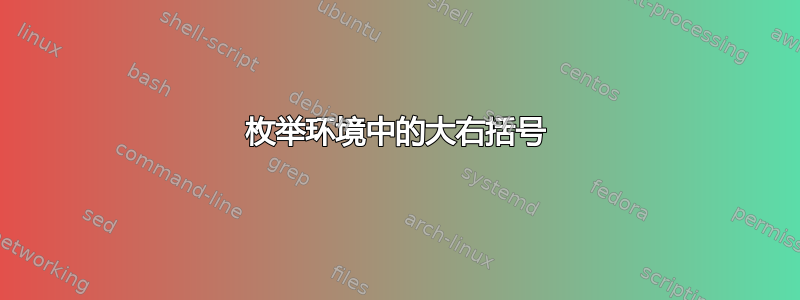
我正在尝试cases使用经典技巧来创建一个右边带有括号的环境\left. \begin{aligned} ... \end{aligned} \right\},但特殊之处在于我处于枚举环境中,这会给我以下结果,具体取决于我在环境[t]中放置的位置aligned。
以下是产生该结果的代码:
\documentclass[fleqn, 12pt]{article}
\usepackage{amsmath}
\begin{document}
\begin{enumerate}
\item
$\begin{aligned}
\left.
\begin{aligned}[t]
&y=\frac{d}{x} \, \Rightarrow \, y^2=\frac{d^2}{x^2} \\[1ex]
&y^2=db-dx
\end{aligned} \right\}
\end{aligned}$
\item
$\begin{aligned}[t]
\left.
\begin{aligned}
&y=\frac{d}{x} \, \Rightarrow \, y^2=\frac{d^2}{x^2} \\[1ex]
&y^2=db-dx
\end{aligned} \right\}
\end{aligned}$
\end{enumerate}
\end{document}
而且,rcases环境给出了与 2 相同的结果。
问题是我两者都不想要。我想要两者的混合,其中第一个方程与 1. 或 2. 对齐,并且括号不要太大。
提前感谢您的回答!
答案1
您可以测量顶部的高度aligned(不带支架)和aligned带支架的高度。然后降低后者,使参考点与前者一致。
\documentclass[fleqn, 12pt]{article}
\usepackage{amsmath}
\NewDocumentEnvironment{itemaligned}{b}{%
\sbox0{$\begin{aligned}[t]#1\end{aligned}$}%
\sbox2{$\left.\begin{aligned}#1\end{aligned}\right\}$}%
\raisebox{\dimeval{\ht0-\ht2}}{\usebox{2}}%
}{}
\begin{document}
\begin{enumerate}
\item
\begin{itemaligned}
&y=\frac{d}{x} \, \Rightarrow \, y^2=\frac{d^2}{x^2} \\[1ex]
&y^2=db-dx
\end{itemaligned}
\end{enumerate}
\end{document}
您可以稍加修改地添加一个以括号为中心的公式:这样的公式应该作为可选参数,itemaligned如下面的代码所示。
\documentclass[fleqn, 12pt]{article}
\usepackage{amsmath}
\NewDocumentEnvironment{itemaligned}{ob}{%
\sbox0{$\begin{aligned}[t]#2\end{aligned}$}%
\sbox2{%
$\left.\begin{aligned}#2\end{aligned}\right\}%
\IfValueT{#1}{\displaystyle{}#1}$%
}%
\raisebox{\dimeval{\ht0-\ht2}}{\usebox{2}}%
}{}
\begin{document}
\begin{enumerate}
\item
\begin{itemaligned}[\Rightarrow \frac{d^2}{x^2}=db-dx]
&y=\frac{d}{x} \, \Rightarrow \, y^2=\frac{d^2}{x^2} \\[1ex]
&y^2=db-dx
\end{itemaligned}
\end{enumerate}
\end{document}
答案2
带有包tikzmark库。为了使用美观的括号,还tikz使用了:decorations.pathreplacingcalligraphy
\documentclass[fleqn, 12pt]{article}
\usepackage{mathtools}
\usepackage{tikz}
\usetikzlibrary{decorations.pathreplacing,%
calligraphy,% had to be after decorations.pathreplacing
tikzmark}
\tikzset{BC/.style = {decorate,
decoration={calligraphic brace, amplitude=6pt,
pre =moveto, pre length=1pt,
post=moveto, post length=1pt,
raise = 6pt,
#1},% for mirroring of brace, if needed
ultra thick,
pen colour={black}},
}
\begin{document}
\begin{enumerate}
\item
$\begin{aligned}[t]
y & = \dfrac{d}{x} \, \Rightarrow \, y^2 = \tikzmarknode{A}{\dfrac{d^2}{x^2}} \\
y^2 & = db - \tikzmarknode{B}{dx} \\
\end{aligned}$
\item
$\begin{aligned}[t]
y & = \dfrac{d}{x} \, \Rightarrow \, y^2 = \tikzmarknode{C}{\dfrac{d^2}{x^2}} \\
y^2 & = db-dx & \\
E & = M\cdot\tikzmarknode{D}{C^2} & \\
\end{aligned}$
\end{enumerate}
\begin{tikzpicture}[overlay, remember picture]
\draw[BC] (A.north east) -- (A.east |- B.south);
\draw[BC] (C.north east) -- (C.east |- D.south);
\end{tikzpicture}
\end{document}
经过至少两次编译后,上述 MWE 的结果是:
使用此解决方案,您可以更改括号的颜色。例如,通过设置将它们变为红色pen colour={red}。
附录:
在某些情况下,当您希望花括号遵循某个等式时,只需将具有该等式的节点添加到花括号中:
\documentclass[fleqn, 12pt]{article}
\usepackage{mathtools}
\usepackage{tikz}
\usetikzlibrary{decorations.pathreplacing,%
calligraphy,% had to be after decorations.pathreplacing
tikzmark}
\tikzset{BC/.style = {decorate,
decoration={calligraphic brace, amplitude=6pt,
pre =moveto, pre length=1pt,
post=moveto, post length=1pt,
raise = 6pt,
#1},% for mirroring of brace, if needed
ultra thick,
pen colour={black}},
}
\begin{document}
\begin{enumerate}
\item
$\begin{aligned}[t]
y & = \dfrac{d}{x} \, \Rightarrow \, y^2 = \tikzmarknode{A}{\dfrac{d^2}{x^2}} \\
y^2 & = db - \tikzmarknode{B}{dx} \\
\end{aligned}$
\end{enumerate}
\begin{tikzpicture}[overlay, remember picture]
\draw[BC] (A.north east) -- node[right=5mm] {$\dfrac{d^2}{x^2}=db-dx$} (A.east |- B.south); % <---
\end{tikzpicture}
\end{document}
答案3
提出这个想法作为解决方法。取决于您的实际用途,此方法可能不起作用。一定有更好的解决方案。
使用tabularenv 在不同的行中输入方程式,并使用multirow和resizebox输入合适大小的右括号。
以下是代码:
\documentclass[fleqn, 12pt]{article}
\usepackage{amsmath}
\usepackage{multirow}
\usepackage{graphicx}
\begin{document}
\begin{enumerate}
\item\renewcommand{\arraystretch}{1.8}
\begin{tabular}[t]{l@{}l}
$\displaystyle y=\frac{d}{x} \, \Rightarrow \, y^2=\frac{d^2}{x^2}$&\multirow{2}{*}{\resizebox{11pt}{28pt}{\}}}\\
$y^2=db-dx$\\
\end{tabular}
\item
\begin{tabular}[t]{l@{}l}
$\displaystyle y=\frac{d}{x} \, \Rightarrow \, y^2=\frac{d^2}{x^2}$&\multirow{3}{*}{\resizebox{11pt}{48pt}{\}}}\\
$y^2=db-dx$\\
$E=M\cdot C^2$\\
\end{tabular}
\end{enumerate}
\end{document}








